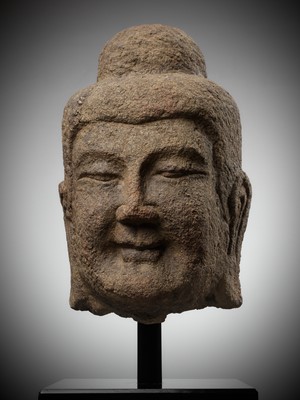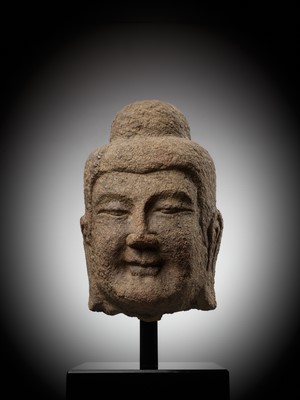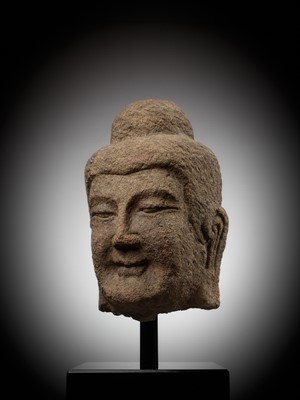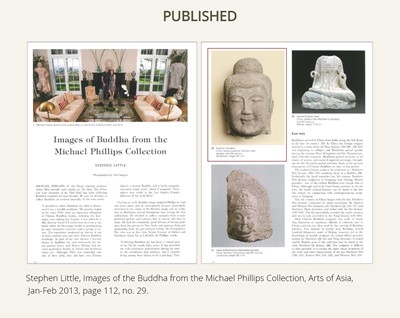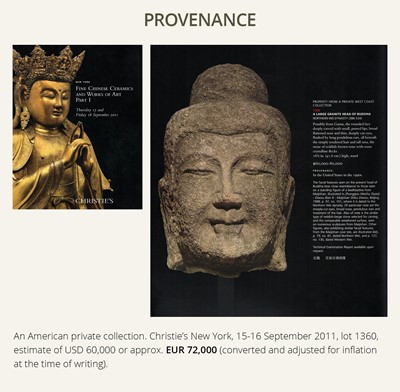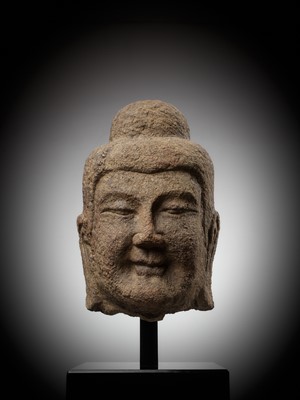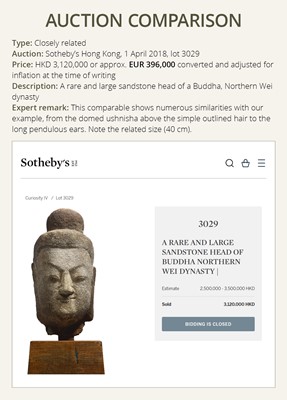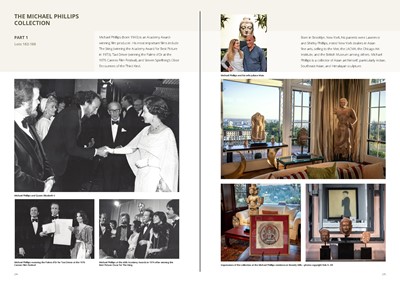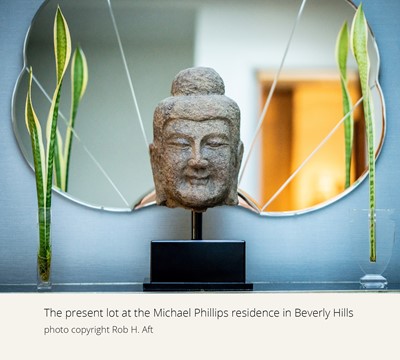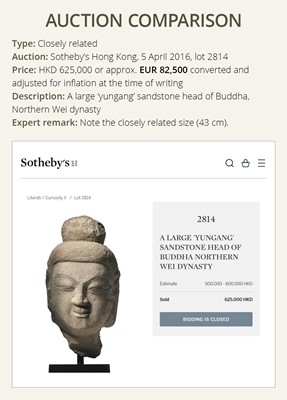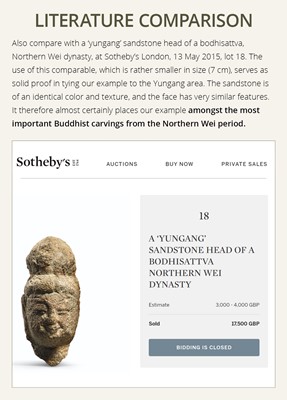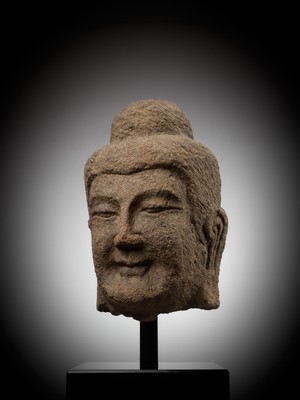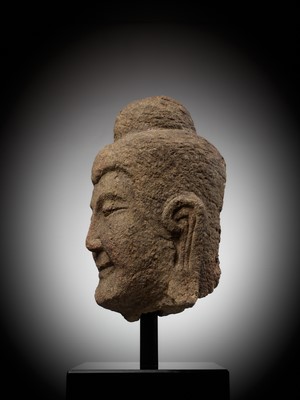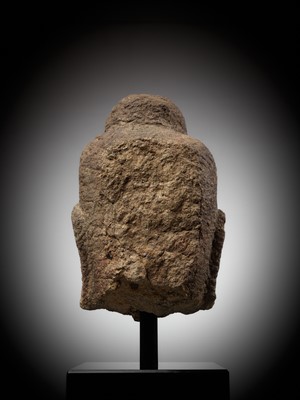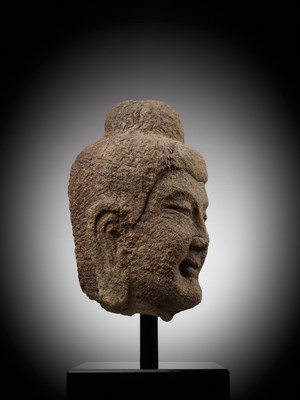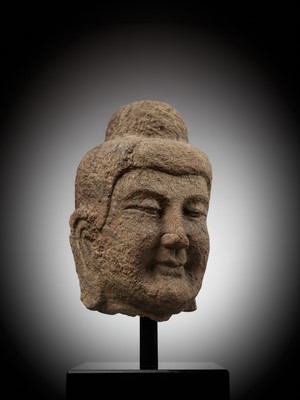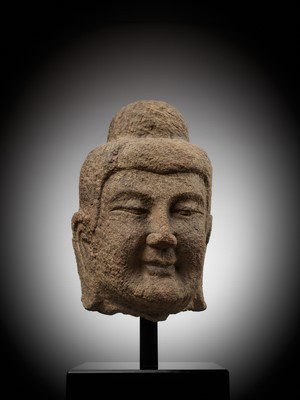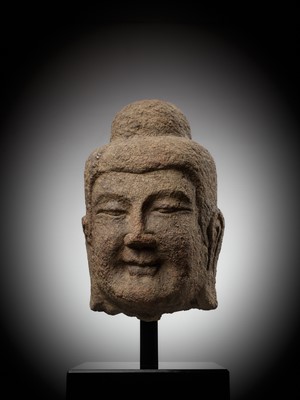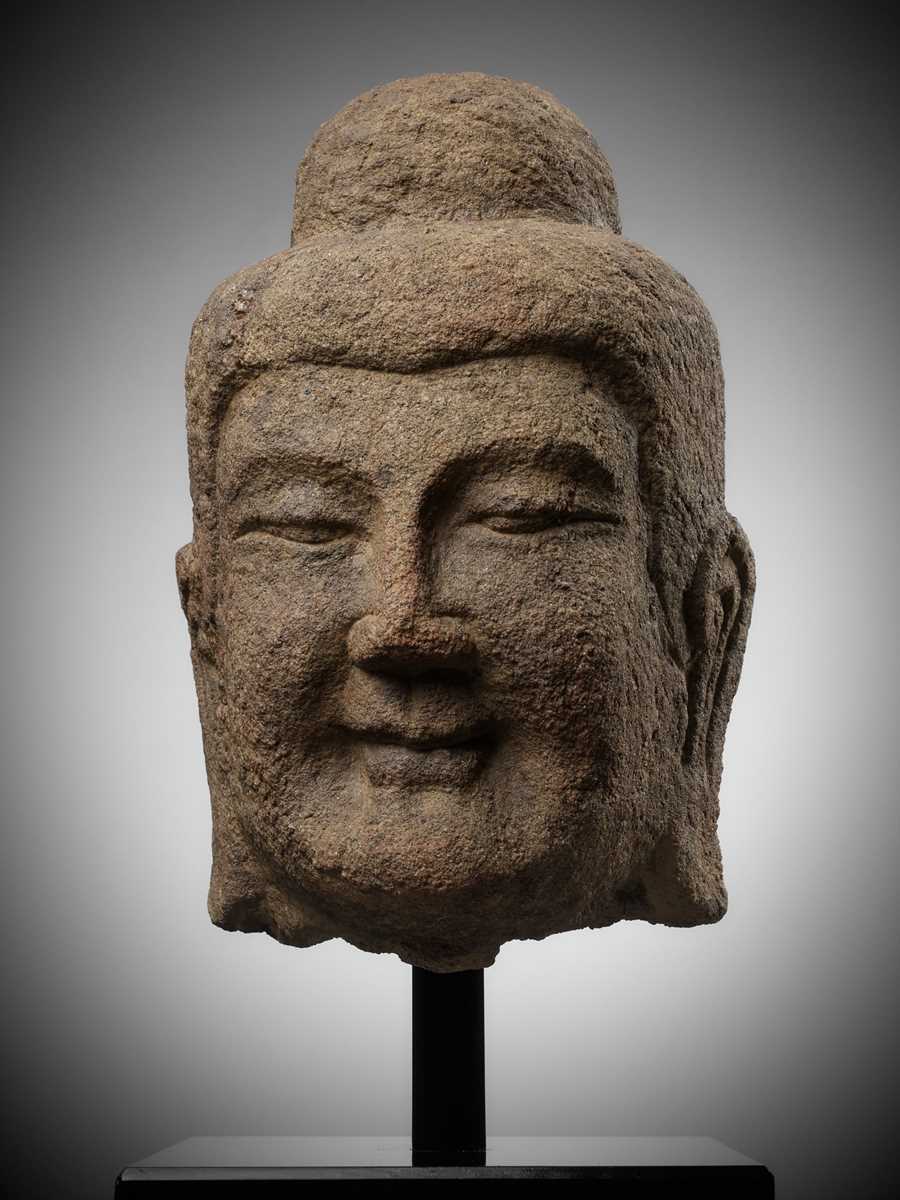9th Mar, 2023 13:00
TWO-DAY AUCTION - Fine Chinese Art / 中國藝術集珍 / Buddhism & Hinduism
182
A MONUMENTAL SANDSTONE HEAD OF BUDDHA, NORTHERN WEI DYNASTY, CHINA, 386-534
386-534年北魏砂岩佛陀頭像
Sold for €26,000
including Buyer's Premium
Opinion: The head is carved from buff sandstone that has the appearance of granite from a distance. The style and material are typical of examples from the Yungang caves and surrounding area.
Published: Stephen Little, Images of the Buddha from the Michael Phillips Collection, Arts of Asia, Jan-Feb 2013, page 112, no. 29.
The rounded face deeply carved with small, pursed lips, broad flattened nose and thin, sharply cut eyes, flanked by long pendulous ears, all beneath the simply rendered hair and tall ushnisha. The stone of reddish-brown tone with some crystalline flecks.
Provenance: An American private collection. Christie’s New York, 15-16 September 2011, lot 1360, estimate of USD 60,000 or approx. EUR 72,000 (converted and adjusted for inflation at the time of writing). The private collection of Michael Phillips (born 1943), who is an Academy Award-winning film producer. Born in Brooklyn, New York, his parents were Lawrence and Shirley Phillips, noted New York dealers in Asian fine arts, selling to the Met, the LACMA, the Chicago Art Institute, and the British Museum among others. Michael Phillips is a collector of Asian art himself, particularly Indian, Southeast Asian, and Himalayan sculpture. His most important films include The Sting (winning the Academy Award for Best Picture in 1973), Taxi Driver (winning the Palme d’Or at the 1976 Cannes Film Festival), and Steven Spielberg’s Close Encounters of the Third Kind.
Condition: Good condition, commensurate with age. Extensive wear, losses, nicks, scratches, signs of weathering and erosion.
Scientific Analysis Report: A scientific and technical examination was conducted by John Twilley, art conservation scientist. A copy of the examination report, dated 20 September 2007, accompanies this lot. The report concludes that “the evidence strongly supports a history of natural weathering of the stone, on a scale of centuries rather than decades, subsequent to its carving”. Note that this report is also mentioned in the catalog entry by Christies from 15-16 September 2011.
Dimensions: Height 43 cm (excl. stand) and 65 cm (incl. stand)
Mounted on an associated stand. (2)
The first of the formative phases of Buddhist sculpture in China, to which the current sculpture dates, lasted until roughly 495 AD and is represented by the cave temples in the north at Yungang. Over 50,000 statues lay within the Yungang Grottoes and surrounding area. Constructed during the Northern Wei dynasty by the imperial order of Emperor Wencheng, carving in the area began in 460 AD as an act of reparation for the Buddhist persecution of 445-452, and lasted until 494 AD when the capital was moved to Luoyang. The Yungang cliff is formed of horizontal layers of buff-colored sandstone, which lends itself well to sculpture, as well as to the excavation of large caves with horizontal ceilings. The sandstone of this head of Buddha is typical of that found in the Yungang region.
Literature comparison:
Compare a polychromed figure of Buddha still in place in Cave 9 of the Yungang Grottoes. Compare a related sandstone head of Buddha with similar features and carved of the same type of stone in The Nelson-Atkins Museum of Art, illustrated in the Handbook of the Collection, Kansas City, 1993, p. 303. Also compare with a ‘yungang’ sandstone head of a bodhisattva, Northern Wei dynasty, at Sotheby’s London, 13 May 2015, lot 18. The use of this comparable, which is rather smaller in size (7 cm), serves as solid proof in tying our example to the Yungang area. The sandstone is of an identical color and texture, and the face has very similar features. It therefore almost certainly places our example amongst the most important Buddhist carvings from the Northern Wei period.
Auction result comparison:
Type: Closely related
Auction: Sotheby’s Hong Kong, 1 April 2018, lot 3029
Price: HKD 3,120,000 or approx. EUR 396,000 converted and adjusted for inflation at the time of writing
Description: A rare and large sandstone head of a Buddha, Northern Wei dynasty
Expert remark: This comparable shows numerous similarities with our example, from the domed ushnisha above the simple outlined hair to the long pendulous ears. Note the related size (40 cm).
Auction result comparison:
Type: Closely related
Auction: Sotheby’s Hong Kong, 5 April 2016, lot 2814
Price: HKD 625,000 or approx. EUR 82,500 converted and adjusted for inflation at the time of writing
Description: A large ‘yungang’ sandstone head of Buddha, Northern Wei dynasty
Expert remark: Note the closely related size (43 cm).
386-534年北魏砂岩佛陀頭像
臉形長圓,彎眉杏眼,唇角上揚微笑,雙眼微開,正向下俯視,兩側是長長的耳垂,眉彎連著鼻脛。佛肉髻有漩渦發紋,五官線條柔和,是北魏漢化後溫文儒雅的相貌。紅棕色調的石頭,帶有一些結晶斑點。頭像由淺黃色砂岩雕刻而成,從遠處看就像花崗岩,是典型的雲岡石窟和周邊地區的風格和材料。
出版:Stephen Little,〈Images of the Buddha from the Michael Phillips Collection〉,《Arts of Asia》,2013年1-2月,第112頁,圖 29。
來源:美國私人收藏;紐約佳士得,2011年9月15-16日,lot 1360,估價USD 60,000 或相當於EUR 72,000 (根據通貨膨脹率);Michael Phillips (出生於1943)私人收藏,他是一位電影製片人,曾獲得奧斯卡獎。他出生在紐約布魯克林,父母是Lawrence 與Shirley Phillips,他們是著名的紐約亞洲美術經銷商,向大都會博物館、洛杉磯美術館、芝加哥藝術學院和大英博物館等機構出售藝術品。Michael Phillips本人是亞洲藝術收藏家,尤其是印度、東南亞和喜馬拉雅地區造像。他最重要的電影包括《刺激》(1973 年獲得奧斯卡最佳影片獎)、《計程車司機》(1976 年戛納電影節金棕櫚獎)和史蒂文·斯皮爾伯格的《第三類接觸》。
品相:條件良好,大面積磨損、缺損、刻痕、劃痕、風化和侵蝕。
科學檢測報告:藝術保護科學家John Twilley對此頭像進行了科學檢測。本拍品附有一份日期為 2007年 9 月 20 日的檢驗報告複印本。該報告得出結論,“證據有力地支持了石頭在雕刻之後的自然風化歷史,其規模為數百年而不是數十年”。請注意,佳士得 2011年 9 月 15 日至 16 日的圖錄中也提到了這份報告。
尺寸:高 43 釐米 (不含底座) 與65 釐米 (含底座)
配置底座。 (2)
目前的這件造像可以追溯到中國佛教造像的第一個形成階段,一直持續到大約公元 495 年,以北部雲岡石窟寺為代表。雲岡石窟及周邊地區共有造像5萬多尊。由文成皇帝下令在北魏時期建造,該地區的造像始於西元 460 年,一直持續到西元 494 年遷都洛陽。雲岡石窟由淺黃色砂岩層構成,非常適合雕刻,也適合挖掘帶有穹頂的大型洞穴。這尊佛頭的砂岩是雲岡地區典型的砂岩。
文獻比較:
比較一件彩繪佛像,現存於雲岡石窟第9窟。 比較一件具有相似特徵和由同一類型石頭雕刻而成的砂岩佛像,收藏於納爾遜-阿特金斯藝術博物館,見《the Handbook of the Collection》,堪薩斯市,1993 年,頁303。 比較另一尊北魏“雲崗”砂岩菩薩頭像,於倫敦蘇富比,2015 年 5 月 13 日,拍品編號 18。這件比較小的尺寸(7 厘米),是我們的例子與雲岡地區聯繫起來的有力證明。砂岩的顏色和質地一模一樣,臉部五官也很相像。因此,幾乎可以肯定,我們的例子是北魏時期最重要的佛教雕刻之一。
拍賣結果比較:
形制:非常相近
拍賣:香港蘇富比,2018年4月1日,lot 3029
價格:HKD 3,120,000(相當於今日EUR 396,000)
描述:北魏砂岩雕佛首
專家評論:此尊佛首與我們的拍品有許多相似之處,簡單輪廓的頭髮、下垂的長耳朵。請注意相近 尺寸(40 厘米)。
拍賣結果比較:
形制:非常相近
拍賣:香港蘇富比,2016年4月5日,lot 2814
價格:HKD 625,000(相當於今日EUR 82,500)
描述:北魏砂岩石雕雲岡式佛頭像
專家評論:請注意非常相近尺寸(43 厘米)。
Opinion: The head is carved from buff sandstone that has the appearance of granite from a distance. The style and material are typical of examples from the Yungang caves and surrounding area.
Published: Stephen Little, Images of the Buddha from the Michael Phillips Collection, Arts of Asia, Jan-Feb 2013, page 112, no. 29.
The rounded face deeply carved with small, pursed lips, broad flattened nose and thin, sharply cut eyes, flanked by long pendulous ears, all beneath the simply rendered hair and tall ushnisha. The stone of reddish-brown tone with some crystalline flecks.
Provenance: An American private collection. Christie’s New York, 15-16 September 2011, lot 1360, estimate of USD 60,000 or approx. EUR 72,000 (converted and adjusted for inflation at the time of writing). The private collection of Michael Phillips (born 1943), who is an Academy Award-winning film producer. Born in Brooklyn, New York, his parents were Lawrence and Shirley Phillips, noted New York dealers in Asian fine arts, selling to the Met, the LACMA, the Chicago Art Institute, and the British Museum among others. Michael Phillips is a collector of Asian art himself, particularly Indian, Southeast Asian, and Himalayan sculpture. His most important films include The Sting (winning the Academy Award for Best Picture in 1973), Taxi Driver (winning the Palme d’Or at the 1976 Cannes Film Festival), and Steven Spielberg’s Close Encounters of the Third Kind.
Condition: Good condition, commensurate with age. Extensive wear, losses, nicks, scratches, signs of weathering and erosion.
Scientific Analysis Report: A scientific and technical examination was conducted by John Twilley, art conservation scientist. A copy of the examination report, dated 20 September 2007, accompanies this lot. The report concludes that “the evidence strongly supports a history of natural weathering of the stone, on a scale of centuries rather than decades, subsequent to its carving”. Note that this report is also mentioned in the catalog entry by Christies from 15-16 September 2011.
Dimensions: Height 43 cm (excl. stand) and 65 cm (incl. stand)
Mounted on an associated stand. (2)
The first of the formative phases of Buddhist sculpture in China, to which the current sculpture dates, lasted until roughly 495 AD and is represented by the cave temples in the north at Yungang. Over 50,000 statues lay within the Yungang Grottoes and surrounding area. Constructed during the Northern Wei dynasty by the imperial order of Emperor Wencheng, carving in the area began in 460 AD as an act of reparation for the Buddhist persecution of 445-452, and lasted until 494 AD when the capital was moved to Luoyang. The Yungang cliff is formed of horizontal layers of buff-colored sandstone, which lends itself well to sculpture, as well as to the excavation of large caves with horizontal ceilings. The sandstone of this head of Buddha is typical of that found in the Yungang region.
Literature comparison:
Compare a polychromed figure of Buddha still in place in Cave 9 of the Yungang Grottoes. Compare a related sandstone head of Buddha with similar features and carved of the same type of stone in The Nelson-Atkins Museum of Art, illustrated in the Handbook of the Collection, Kansas City, 1993, p. 303. Also compare with a ‘yungang’ sandstone head of a bodhisattva, Northern Wei dynasty, at Sotheby’s London, 13 May 2015, lot 18. The use of this comparable, which is rather smaller in size (7 cm), serves as solid proof in tying our example to the Yungang area. The sandstone is of an identical color and texture, and the face has very similar features. It therefore almost certainly places our example amongst the most important Buddhist carvings from the Northern Wei period.
Auction result comparison:
Type: Closely related
Auction: Sotheby’s Hong Kong, 1 April 2018, lot 3029
Price: HKD 3,120,000 or approx. EUR 396,000 converted and adjusted for inflation at the time of writing
Description: A rare and large sandstone head of a Buddha, Northern Wei dynasty
Expert remark: This comparable shows numerous similarities with our example, from the domed ushnisha above the simple outlined hair to the long pendulous ears. Note the related size (40 cm).
Auction result comparison:
Type: Closely related
Auction: Sotheby’s Hong Kong, 5 April 2016, lot 2814
Price: HKD 625,000 or approx. EUR 82,500 converted and adjusted for inflation at the time of writing
Description: A large ‘yungang’ sandstone head of Buddha, Northern Wei dynasty
Expert remark: Note the closely related size (43 cm).
386-534年北魏砂岩佛陀頭像
臉形長圓,彎眉杏眼,唇角上揚微笑,雙眼微開,正向下俯視,兩側是長長的耳垂,眉彎連著鼻脛。佛肉髻有漩渦發紋,五官線條柔和,是北魏漢化後溫文儒雅的相貌。紅棕色調的石頭,帶有一些結晶斑點。頭像由淺黃色砂岩雕刻而成,從遠處看就像花崗岩,是典型的雲岡石窟和周邊地區的風格和材料。
出版:Stephen Little,〈Images of the Buddha from the Michael Phillips Collection〉,《Arts of Asia》,2013年1-2月,第112頁,圖 29。
來源:美國私人收藏;紐約佳士得,2011年9月15-16日,lot 1360,估價USD 60,000 或相當於EUR 72,000 (根據通貨膨脹率);Michael Phillips (出生於1943)私人收藏,他是一位電影製片人,曾獲得奧斯卡獎。他出生在紐約布魯克林,父母是Lawrence 與Shirley Phillips,他們是著名的紐約亞洲美術經銷商,向大都會博物館、洛杉磯美術館、芝加哥藝術學院和大英博物館等機構出售藝術品。Michael Phillips本人是亞洲藝術收藏家,尤其是印度、東南亞和喜馬拉雅地區造像。他最重要的電影包括《刺激》(1973 年獲得奧斯卡最佳影片獎)、《計程車司機》(1976 年戛納電影節金棕櫚獎)和史蒂文·斯皮爾伯格的《第三類接觸》。
品相:條件良好,大面積磨損、缺損、刻痕、劃痕、風化和侵蝕。
科學檢測報告:藝術保護科學家John Twilley對此頭像進行了科學檢測。本拍品附有一份日期為 2007年 9 月 20 日的檢驗報告複印本。該報告得出結論,“證據有力地支持了石頭在雕刻之後的自然風化歷史,其規模為數百年而不是數十年”。請注意,佳士得 2011年 9 月 15 日至 16 日的圖錄中也提到了這份報告。
尺寸:高 43 釐米 (不含底座) 與65 釐米 (含底座)
配置底座。 (2)
目前的這件造像可以追溯到中國佛教造像的第一個形成階段,一直持續到大約公元 495 年,以北部雲岡石窟寺為代表。雲岡石窟及周邊地區共有造像5萬多尊。由文成皇帝下令在北魏時期建造,該地區的造像始於西元 460 年,一直持續到西元 494 年遷都洛陽。雲岡石窟由淺黃色砂岩層構成,非常適合雕刻,也適合挖掘帶有穹頂的大型洞穴。這尊佛頭的砂岩是雲岡地區典型的砂岩。
文獻比較:
比較一件彩繪佛像,現存於雲岡石窟第9窟。 比較一件具有相似特徵和由同一類型石頭雕刻而成的砂岩佛像,收藏於納爾遜-阿特金斯藝術博物館,見《the Handbook of the Collection》,堪薩斯市,1993 年,頁303。 比較另一尊北魏“雲崗”砂岩菩薩頭像,於倫敦蘇富比,2015 年 5 月 13 日,拍品編號 18。這件比較小的尺寸(7 厘米),是我們的例子與雲岡地區聯繫起來的有力證明。砂岩的顏色和質地一模一樣,臉部五官也很相像。因此,幾乎可以肯定,我們的例子是北魏時期最重要的佛教雕刻之一。
拍賣結果比較:
形制:非常相近
拍賣:香港蘇富比,2018年4月1日,lot 3029
價格:HKD 3,120,000(相當於今日EUR 396,000)
描述:北魏砂岩雕佛首
專家評論:此尊佛首與我們的拍品有許多相似之處,簡單輪廓的頭髮、下垂的長耳朵。請注意相近 尺寸(40 厘米)。
拍賣結果比較:
形制:非常相近
拍賣:香港蘇富比,2016年4月5日,lot 2814
價格:HKD 625,000(相當於今日EUR 82,500)
描述:北魏砂岩石雕雲岡式佛頭像
專家評論:請注意非常相近尺寸(43 厘米)。
Zacke Live Online Bidding
Our online bidding platform makes it easier than ever to bid in our auctions! When you bid through our website, you can take advantage of our premium buyer's terms without incurring any additional online bidding surcharges.
To bid live online, you'll need to create an online account. Once your account is created and your identity is verified, you can register to bid in an auction up to 12 hours before the auction begins.
Intended Spend and Bid Limits
When you register to bid in an online auction, you will need to share your intended maximum spending budget for the auction. We will then review your intended spend and set a bid limit for you. Once you have pre-registered for a live online auction, you can see your intended spend and bid limit by going to 'Account Settings' and clicking on 'Live Bidding Registrations'.
Your bid limit will be the maximum amount you can bid during the auction. Your bid limit is for the hammer price and is not affected by the buyer’s premium and VAT. For example, if you have a bid limit of €1,000 and place two winning bids for €300 and €200, then you will only be able to bid €500 for the rest of the auction. If you try to place a bid that is higher than €500, you will not be able to do so.
Online Absentee and Telephone Bids
You can now leave absentee and telephone bids on our website!
Absentee Bidding
Once you've created an account and your identity is verified, you can leave your absentee bid directly on the lot page. We will contact you when your bids have been confirmed.
Telephone Bidding
Once you've created an account and your identity is verified, you can leave telephone bids online. We will contact you when your bids have been confirmed.
Classic Absentee and Telephone Bidding Form
You can still submit absentee and telephone bids by email or fax if you prefer. Simply fill out the Absentee Bidding/Telephone bidding form and return it to us by email at office@zacke.at or by fax at +43 (1) 532 04 52 20. You can download the PDF from our Upcoming Auctions page.
How-To Guides
How to Create Your Personal Zacke Account
How to Register to Bid on Zacke Live
How to Leave Absentee Bids Online
How to Leave Telephone Bids Online
中文版本的操作指南
创建新账号
注册Zacke Live在线直播竞拍(免平台费)
缺席投标和电话投标
Third-Party Bidding
We partner with best-in-class third-party partners to make it easy for you to bid online in the channel of your choice. Please note that if you bid with one of our third-party online partners, then there will be a live bidding surcharge on top of your final purchase price. You can find all of our fees here. Here's a full list of our third-party partners:
- 51 Bid Live
- EpaiLive
- ArtFoxLive
- Invaluable
- LiveAuctioneers
- the-saleroom
- lot-tissimo
- Drouot
Please note that we place different auctions on different platforms. For example, in general, we only place Chinese art auctions on 51 Bid Live.
Bidding in Person
You must register to bid in person and will be assigned a paddle at the auction. Please contact us at office@zacke.at or +43 (1) 532 04 52 for the latest local health and safety guidelines.
